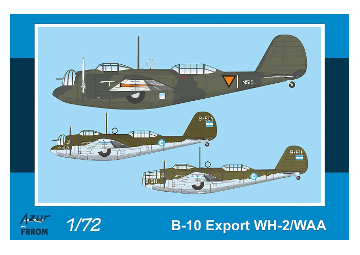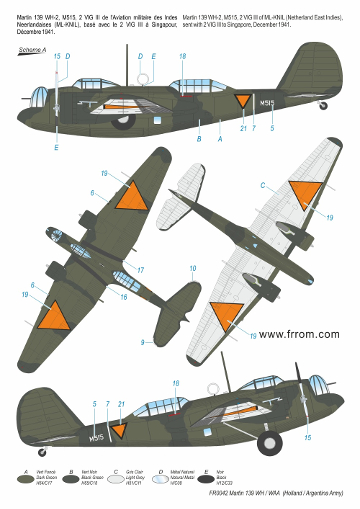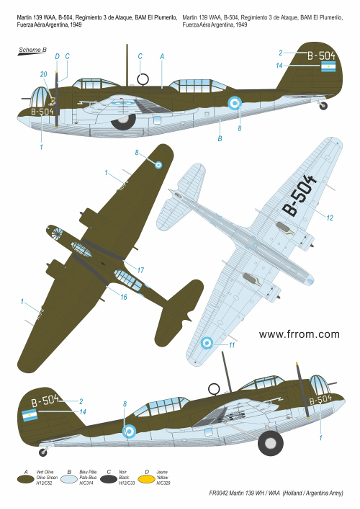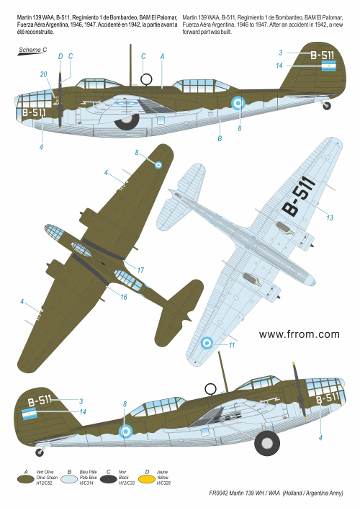FR0042 B-10B Export WH-2/WAA
History:
The prototype B-10 first flew on February 16, 1932, with delivery to the US Army Air Corps (USAAC) for testing on March 20. The B-10 combined several innovations including an all-metal airframe, fully cowled engines, retractable landing gear, enclosed gun-turret, and internal bomb-bay, which helped make it faster than fighters then in service and all other bombers obsolete. In doing so, it set the pattern that most subsequent bomber designs would emulate until the jet-age. Although built in relatively small numbers, the B-10 was revolutionary, and was the USAAC’s first all-metal monoplane bomber.

It defined the transition in eras from fabric-covered biplane to all-metal streamlined monoplane bombers defended by enclosed gun positions. In 1933, 14 pre-production YB-10s were ordered in January and delivered in November. The USAAC received 103 of the main production version, the B-10B, equipped with more powerful 675 hp Wright Cyclone R-1820-19 engines, and seven equipped with Pratt & Whitney Hornet engines which were designated B-12.
The B-10 was cleared for export in July 1936 as the Model 139 with Wright engines and received designations reflecting the model (139), engine (W for Wright), country (first letter), and service user if applicable (A for army and N for navy). Customers included China (nine 139 WC), Argentina (22 139 WAA and 12 139 WAN), Turkey (20 139 WT), the Kingdom of Siam (six 139 WSM), and the Dutch East Indies which was the biggest user (13 139 WH-1, 26 139 WH-2, as well as 82 of an improved version, the Model 166 WH-3). One plane was also exported to the Soviet Union (139 WR) and another one to Japan (139 WJ). The latter country captured a few 139 WH-2 and WH-3 after the invasion of the Dutch East Indies, and passed these on to the Thai Air Force in 1944. The Kingdom of Siam used its 139 WSM against French Indo-China during the Franco-Thai war of January/February 1941
A first batch of 13 Model 139s WH-1 (Wright Cyclone R-1820-F53 engines delivering 770 hp) was shipped to the Militaire Luchtvaart van het Koninklijk Nederlands-Indisch Leger, (ML-KNIL), and registered M501 to M513. The second batch of WH-2s (Wright Cyclone R-1820-G3 engines) was delivered to the ML-KNIL and numbered M514 to M539. The next delivery were Model 166 WH-3 and WH-3A. The Model 166 was an extensively modified Model 139, with the addition of a long canopy extending from the pilot’s to rear gunner’s station, bomb-shackles between the engines and fuselage, and 900 hp engines. All Model 139s and 166s were delivered to the ML-KNIL in the standard American colours of the time, with yellow wings, blue fuselage, and marked with Dutch roundels in the usual six positions. At the end of 1939, the roundels were replaced by large orange “neutrality” triangles with black edges. The triangles were deleted on top of the wings in July 1940. The aircraft were then camouflaged in two shades of green on top, light grey underneath from 16 August 1940.
After the Japanese attack in December 1941, these bombers were used to defend the Dutch East Indies. Aircraft of 2-Vl.G.III were sent to Singapore, again with “neutrality” triangles of top of the wings. On December 17, 1941, at the request of the Navy, the "WH-1 Patrol" was formed, composed of aircraft numbers M-503, M505, and M510. On March 8, 1942, aircraft M-585 (a 166 WH-3A) managed to escape to Australia where it later received US national insignia.
In 1936, the Argentinean Army launched an international call for tenders for 22 bombers, 30 fighters, 30 attack aircraft and three navigation and bombing training aircraft, 20 basic training aircraft, and 30 advanced training aircraft, with the aim of selecting designs using common engine type and accessories. For bombing, the Army chose the Model 139 in preference to the Junkers Ju 86 and the Savoia-Marchetti SM 79B (twin-engine version). The Argentinean government thus ordered 22 Model 139s WAA equipped with Wright Cyclone R-1820-G3, and three Focke-Wulf Fw 58B Weihe for training (see kit #FR010).
The Model 139s were registered 501 to 522 and assigned to the Base Aérea Militar d'El Palomar, located in the suburbs of Buenos Aires. They were used for crew training from April 1938. On 20 March 1939, aircraft 507 was destroyed during training. In 1940, some 139 WAAs were assigned to the Regimiento Aéreo 1, on the BAM Coronel Pringles in Villa Reynolds (San Luis province). Aircraft 519 was destroyed on October 30, 1939, and 520 crashed on March 20, 1941. Following this the carburettors were replaced on all aircraft. In 1942, the 19 remaining Model 139s were assigned to the RA 1. Aircraft 502, 509, 510, and 522 went to Rio Grande, Tierra del Fuego, between the end of April and May 11, 1943. Aircraft 508, 518, and 522 flew to Santiago de Chile in September 1943 to take part in the Independence Day celebrations.
The Model 139s WAA served in natural metal marked with roundels and codes on and under the wings and on the fuselage, a large fin flag, and the code on the leading edge of the wings. From October 1943 they were camouflaged in green above and pale blue below, with a small fin flag, and code displayed on the nose and tail. In January 1944, the letter B for Bombardero was added before the code.
Aircraft B-511 and B-510 were damaged and received new nose sections inspired by the B-25 Mitchell, giving them a very unusual appearance. In the fall of 1948, seven 139 WAAs were assigned to the Regimiento de Ataque, BAM El Plumerillo, Mendoza. The last flight of a 139 WAA took place on July 12, 1954 (B-512), the surviving bombers being used for ground training and eventually scrapped.
Specifications (WH-2): twin-engined monoplane bomber with retractable landing gear, metal construction, 3 crew members. Engines: two 840 hp Wright Cyclone R-1820-G3. Wingspan 21.49 m, length 13.63 m, wing area 63 m2. Maximum altitude 5,182 m. Offensive armament: 1,029 kg of bombs, defensive armament 3 machine guns.
- Batailles Aériennes n°42 et 42 (on ML-KNIL, in french)
- Avions n°3, 4, 5 with informations on Model 139s WC in China, in french.
- Photos in the web.
- Martin 139W en Argentina, Jorge F. Nunez Padin, Fernando C. Benedetto (Spanish)
- Martin 139 WAN, Jorge F. Nunez Padin, (Museo de la Aviacion Naval - Instituto Aeronaval), Spanish
- Informations and photos generously transmitted by Mark Tutton, Starfighter Decals, on B-10B in Philippines (and elsewhere), by Michel Ledet on Model 139s WH-x in service with ML-KNIL, by Patrick Laureau on Model 139s WC in China, we want to thank them very much for their help !
Camouflages :
- Cam A : Model 139 WH-2, M515, 2 VlG III of ML-KNIL (Netherland East Indies), sent with 2 VlG III to Singapore, December 1941
- Cam B : Model 139 WAA, B-504, Regimiento 3 de Ataque, BAM El Plumerilo, Fuerza Aéra Argentina, 1949
- Cam C : Model 139 WAA, B-511, Regimiento 1 de Bombardeo, BAM El Palomar, Fuerza Aéra Argentina, 1946 to 1947. After an accident in 1942, a new forward part was built.


